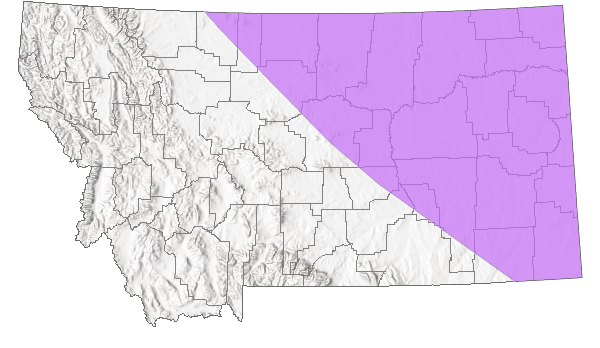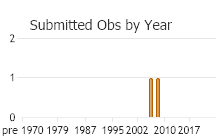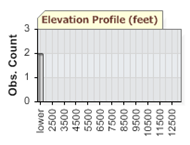View in other NatureServe Network Field Guides
NatureServe
Montana
Utah
Wyoming
Idaho
Wisconsin
British Columbia
South Carolina
Yukon
California
New York
Delaware Skipper - Anatrytone logan
Native Species
Global Rank:
G5
State Rank:
S5
Agency Status
USFWS:
USFS:
BLM:
External Links
General Description
[From Ferris and Brown 1981; Scott 1986; Layberry et al. 1998; Opler and Wright 1999; Glassberg 2001] Forewing 1.5-1.6 cm (males), 1.8 cm (females). Bright yellow-orange, fringes usually orange. Uppersurface with black outer margins, veins with at least some black, sometimes through submarginal to median region, forewing with black bar at end of discal cell and females with a larger elongate black patch at wing base; undersurface of hindwings unmarked yellow-orange.
Phenology
One flight, late June through July northward and in Colorado; several flights southward, February to October in Florida, April to October in Texas (Scott 1986). May to October in south, mid-June through July in north (Glassberg 2001). Mid-July to mid-August in Canada (Layberry et al. 1998). Late June through July in the Rocky Mountain states (Ferris and Brown 1981), late June to late July in Colorado (Scott and Scott 1978), late June through July in North Dakota (Mccabe and Post 1976).
Diagnostic Characteristics
Best determined by a combination of orange-tan fringes, black margins and black wing veins on bright yellow orange uppersurface, unmarked yellow-orange undersurface.
Species Range
Montana Range
Range Descriptions

 Native
Native
Range Comments
Southern Alberta and Saskatchewan south along Rocky Mountain front in Colorado and New Mexico to western Texas, east across extreme southern Canada to southern Ontario, southern New England, and throughout most of eastern US (Ferris and Brown 1981; Scott 1986; Layberry et al. 1998; Opler and Wright 1999; Glassberg 2001). Usually below 1890 m elevation in the Rocky Mountain states (Brown 1957; Scott and Scott 1978; Ferris and Brown 1981). In Montana, reported from at least 13 eastern counties as far west as Hill and Cascade counties (Kohler 1980; Stanford and Opler 1993; FLMNH Lepidopterists' Society database), to at least 1150 m elevation. Mainly rare to uncommon in the western US (Glassberg 2001).
Observations in Montana Natural Heritage Program Database
Number of Observations: 3
(Click on the following maps and charts to see full sized version)
Map Help and Descriptions
Relative Density

Recency



 (Observations spanning multiple months or years are excluded from time charts)
(Observations spanning multiple months or years are excluded from time charts)
Migration
Non-migratory.
Habitat
Wet brushy fields, wet meadows, marshes, prairies, foothills, open woodlands (Ferris and Brown 1981; Scott 1986; Layberry et al. 1998; Opler and Wright 1999; Glassberg 2001); favoring less disturbed prairie over fields and barrens (Nelson 2007; Swengel and Swengel 2015), sometimes present in low numbers in marshes dominated by exotic sedge (Catlin and Kostiuk 2014). Habitat in Montana not described but probably similar.
Food Habits
Larval food plants are grasses, including Andropogon(?), Bromus, Erianthus, and Panicum (Ferris and Brown 1981; Scott 1986, 1992, 2006; Layberry et al. 1998). Adults feed on flower nectar (including Asclepias, Carduus, Cephalanthus, Cirsium, Echinacea, Heterotheca, Medicago, Monarda, Prunella, Silphium, Teucrium, Verbena, Vicea) and mud (Tooker et al. 2002; Scott 2014).
Reproductive Characteristics
Limited information. Females lay eggs singly on host plant leaves. Larvae eat host plant leaves, live in nest of rolled or silk-tied grass leaves, overwinter (diapause) as half-grown (L3-L4 instar?) larvae, emerge in spring and pupate in rolled leaf nest on host plant; adults eclose (emerge) from pupae in 12-13 days in captivity (Scott 1979, 1986, 1992). Males perch throughout the day in grassy swales and gulches awaiting passing females (Scott 1975b, 1986).
Stewardship Responsibility
References
- Literature Cited AboveLegend:
 View Online Publication
View Online Publication Brown, F.M. 1957. Colorado Butterflies. Proceedings; Numbers Three through Seven. Denver Museum of Natural History, Denver, Co.
Brown, F.M. 1957. Colorado Butterflies. Proceedings; Numbers Three through Seven. Denver Museum of Natural History, Denver, Co. Catling, P.M. and B. Kostiuk. 2014. Use of a marsh dominated by the introduced European Lake Sedge, Carex acutiformis, by highly localized native butterflies. Canadian Field-Naturalist 128:358-362.
Catling, P.M. and B. Kostiuk. 2014. Use of a marsh dominated by the introduced European Lake Sedge, Carex acutiformis, by highly localized native butterflies. Canadian Field-Naturalist 128:358-362. Ferris, C.D. and F.M. Brown (eds). 1981. Butterflies of the Rocky Mountains. Univ. of Oklahoma Press. Norman. 442 pp.
Ferris, C.D. and F.M. Brown (eds). 1981. Butterflies of the Rocky Mountains. Univ. of Oklahoma Press. Norman. 442 pp. Glassberg, J. 2001. Butterflies through Binoculars: A Field Guide to the Butterflies of Western North America. Oxford University Press.
Glassberg, J. 2001. Butterflies through Binoculars: A Field Guide to the Butterflies of Western North America. Oxford University Press. Kohler, S. 1980. Checklist of Montana Butterflies (Rhopalocera). Journal of the Lepidopterists' Society 34(1): 1-19.
Kohler, S. 1980. Checklist of Montana Butterflies (Rhopalocera). Journal of the Lepidopterists' Society 34(1): 1-19. Layberry, R.A., P.W. Hall, and J.D. LaFontaine. 1998. The Butterflies of Canada. University of Toronto Press. 280 pp. + color plates.
Layberry, R.A., P.W. Hall, and J.D. LaFontaine. 1998. The Butterflies of Canada. University of Toronto Press. 280 pp. + color plates. McCabe, T.L. and R.L. Post. 1976. North Dakota butterfly calendar (including possible strays). Journal of Research on the Lepidoptera 15:93-99.
McCabe, T.L. and R.L. Post. 1976. North Dakota butterfly calendar (including possible strays). Journal of Research on the Lepidoptera 15:93-99. Nelson, S.M. 2007. Butterflies (Papilionoidea and Hesperiodea) as potential ecological indicators of riparian quality in the semi-arid western United States. Ecological Indicators 7:469-480.
Nelson, S.M. 2007. Butterflies (Papilionoidea and Hesperiodea) as potential ecological indicators of riparian quality in the semi-arid western United States. Ecological Indicators 7:469-480. Opler, P.A. and A.B. Wright. 1999. A field guide to western butterflies. Second edition. Peterson Field Guides. Houghton Mifflin Company, Boston, Massachusetts. 540 pp.
Opler, P.A. and A.B. Wright. 1999. A field guide to western butterflies. Second edition. Peterson Field Guides. Houghton Mifflin Company, Boston, Massachusetts. 540 pp. Scott, J.A. 1975b. Mate-locating behavior of western North American butterflies. Journal of Research on the Lepidoptera 14:1-40.
Scott, J.A. 1975b. Mate-locating behavior of western North American butterflies. Journal of Research on the Lepidoptera 14:1-40. Scott, J.A. 1979. Hibernal diapause of North American Papilionoidea and Hesperioidea. Journal of Research on the Lepidoptera 18(3): 171-200.
Scott, J.A. 1979. Hibernal diapause of North American Papilionoidea and Hesperioidea. Journal of Research on the Lepidoptera 18(3): 171-200. Scott, J.A. 1986. The butterflies of North America: a natural history and field guide. Stanford University Press, Stanford, California.
Scott, J.A. 1986. The butterflies of North America: a natural history and field guide. Stanford University Press, Stanford, California. Scott, J.A. 1992. Hostplant records for butterflies and skippers (mostly from Colorado) 1959-1992, with new life histories and notes on oviposition, immatures, and ecology. Papilio new series #6. 185 p.
Scott, J.A. 1992. Hostplant records for butterflies and skippers (mostly from Colorado) 1959-1992, with new life histories and notes on oviposition, immatures, and ecology. Papilio new series #6. 185 p. Scott, J.A. 2006. Butterfly hostplant records, 1992-2005, with a treatise on the evolution of Erynnis, and a note on new terminology for mate-locating behavior. Papilio new series #14. 74 p.
Scott, J.A. 2006. Butterfly hostplant records, 1992-2005, with a treatise on the evolution of Erynnis, and a note on new terminology for mate-locating behavior. Papilio new series #14. 74 p. Scott, J.A. 2014. Lepidoptera of North America 13. Flower visitation by Colorado butterflies (40,615 records) with a review of the literature on pollination of Colorado plants and butterfly attraction (Lepidoptera: Hersperioidea and Papilionoidea). Contributions of the C.P. Gillette Museum of Arthopod Diversity. Fort Collins, CO: Colorado State University. 190 p.
Scott, J.A. 2014. Lepidoptera of North America 13. Flower visitation by Colorado butterflies (40,615 records) with a review of the literature on pollination of Colorado plants and butterfly attraction (Lepidoptera: Hersperioidea and Papilionoidea). Contributions of the C.P. Gillette Museum of Arthopod Diversity. Fort Collins, CO: Colorado State University. 190 p. Scott, J.A. and G.R. Scott. 1978. Ecology and distribution of the butterflies of southern central Colorado. Journal of Research on the Lepidoptera 17(2): 73-128.
Scott, J.A. and G.R. Scott. 1978. Ecology and distribution of the butterflies of southern central Colorado. Journal of Research on the Lepidoptera 17(2): 73-128. Stanford, R.E. and P.A. Opler. 1993. Atlas of western USA butterflies: including adjacent parts of Canada and Mexico. Unpubl. Report. Denver and Fort Collins, Colorado 275 pp.
Stanford, R.E. and P.A. Opler. 1993. Atlas of western USA butterflies: including adjacent parts of Canada and Mexico. Unpubl. Report. Denver and Fort Collins, Colorado 275 pp. Swengel, A.B and S.R. Swengel. 2015. Grass-skipper (Hesperiinae) trends in midwestern USA grasslands during 1988-2013. Journal of Insect Conservation 19:279-292.
Swengel, A.B and S.R. Swengel. 2015. Grass-skipper (Hesperiinae) trends in midwestern USA grasslands during 1988-2013. Journal of Insect Conservation 19:279-292. Tooker, J.F., P.F. Reagel, and L.M. Hanks. 2002. Nectar sources of day-flying lepidoptera of central Illinois. Annals of the Entomological Society of America 95(1): 84-96.
Tooker, J.F., P.F. Reagel, and L.M. Hanks. 2002. Nectar sources of day-flying lepidoptera of central Illinois. Annals of the Entomological Society of America 95(1): 84-96.
- Additional ReferencesLegend:
 View Online Publication
View Online Publication
Do you know of a citation we're missing? Allen, T.J., J.P. Brock, and J. Glassberg. 2005. Caterpillars in the field and garden: a field guide to the butterfly caterpillars of North America. Oxford University Press.
Allen, T.J., J.P. Brock, and J. Glassberg. 2005. Caterpillars in the field and garden: a field guide to the butterfly caterpillars of North America. Oxford University Press. Brock, J.P. and K. Kaufman. 2003. Kaufman Field Guide to Butterflies of North America. Houghton Mifflin Company, New York, NY 284 pp.
Brock, J.P. and K. Kaufman. 2003. Kaufman Field Guide to Butterflies of North America. Houghton Mifflin Company, New York, NY 284 pp. Forister, M.L., C.A. Halsch, C.C. Nice, J.A. Fordyce, T.E. Dilts, J.C. Oliver, K.L. Prudic, A.M. Shapiro, J.K. Wilson, J. Glassberg. 2021. Fewer butterflies seen by community scientists across the warming and drying landscapes of the American West. Science 371:1042-1045.
Forister, M.L., C.A. Halsch, C.C. Nice, J.A. Fordyce, T.E. Dilts, J.C. Oliver, K.L. Prudic, A.M. Shapiro, J.K. Wilson, J. Glassberg. 2021. Fewer butterflies seen by community scientists across the warming and drying landscapes of the American West. Science 371:1042-1045. Forister, M.L., E.M. Grames, C.A. Halsch, K.J. Burls, C.F. Carroll, K.L. Bell, J.P. Jahner, et al. 2023. Assessing risk for butterflies in the context of climate change, demographic uncertainty, and heterogeneous data sources. Ecological Monographs 93(3):e1584. https://doi.org/10.1002/ecm.1584
Forister, M.L., E.M. Grames, C.A. Halsch, K.J. Burls, C.F. Carroll, K.L. Bell, J.P. Jahner, et al. 2023. Assessing risk for butterflies in the context of climate change, demographic uncertainty, and heterogeneous data sources. Ecological Monographs 93(3):e1584. https://doi.org/10.1002/ecm.1584
- Web Search Engines for Articles on "Delaware Skipper"
- Additional Sources of Information Related to "Insects"





